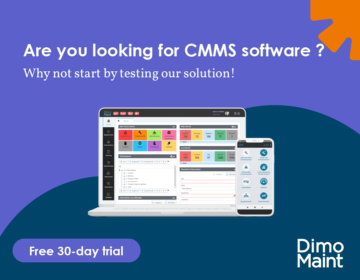What is a CMMS?
CMMS (Computerized Maintenance Management System) is a software solution that helps organizations plan, monitor, and optimize their maintenance operations. It enables companies to:
- Reduce equipment failures and unplanned downtime,
- Extend asset lifespan,
- Improve management of maintenance tasks and teams,
- Make better decisions through data analysis.
A CMMS is relevant to all sectors — including manufacturing, healthcare, energy, construction, and services.
All the CMMS features and dashboards enable you to draw up a comprehensive tree structure of the assets or sites to be maintained, and thereby orchestrate your maintenance operations. Adaptable to all users, the CMMS becomes a real assistant serving continuous activity, and therefore increased machine performance.
Explore CMMS and its features in just 2 minutes

In addition to maintenance operations, the CMMS now covers a wide range of peripheral tasks. Its ability to harness data means that it can be used to produce fine-tuned analyses to boost productivity.
Discover the 4 main reasons for adopting CMMS software
CMMS benefit no. 1: reduced maintenance costs

Storage costs, labour costs, anticipation of maintenance operations and spare parts purchases: well-informed about its future expenditure, the company can anticipate, group its purchases and reduce its costs.
This significantly reduces the cost of maintenance.
CMMS benefit no. 2: Extending the life cycle of expensive assets
Better maintenance means fewer breakdowns, and therefore optimized assets over the long term. Repairs and replacements can be planned in advance, with reduced wear and tear on the machines.
The lifespan of assets is extended by 50% with the use of an assisted maintenance solution.
CMMS benefit no. 3: Productivity gains
Once maintenance has been made reliable by the CMMS, production interruptions and machine downtime are kept to a minimum.
Dashboards provide a real-time view of availability, making it possible to maintain more continuous operation, with a direct impact on productivity.
CMMS benefit no. 4: Better human resources management

Over and above the financial and operational benefits, the CMMS offers many advantages for an organization. The solution ensures safety for field operatives and helps bring equipment into compliance in the most regulated sectors.
Able to analyze and support decision-making, the maintenance solution is a real guarantee of professionalism for any company operating machinery.
The CMMS, the cornerstone of maintenance 4.0

Maintenance 4.0 cannot be implemented without digitalizing the maintenance function. The CMMS then takes its place at the centre of the organization, transmitting valuable information to all the business lines. The software provides a better understanding of your assets and enables data to be analysed using AI and used across the board by circulating it throughout the IS.
The CMMS 4.0 is therefore positioned as both an important decision-making tool and provides real support in the field, where it contributes to the mobility and efficiency of operations. Once the data has been collected, it is naturally escalated to the key maintenance stakeholders.
Exploring the features of CMMS software
Today’s CMMS solutions can cover a wide range of functions. These most often include:
- Asset management:
The CMMS contains an inventory of the machines and their possible tree structure, their location, the date of purchase and maintenance history, as well as the technical documentation.
- Work management:
This is one of the core functions of the CMMS. The tool makes it possible to plan work, whatever its type (preventive maintenance, curative, corrective maintenance, etc.) and to understand its cost.
- Parts purchasing and stock management:
Stocks are essential for the performance of work. The CMMS tracks the entry and issuance of parts, manages relations with suppliers, and receives suggestions and alerts for future purchases.
- Managing staff and the schedule:
The CMMS provides a comprehensive overview of team availability and allows tasks to be assigned according to each person’s remit and history. This management can be extended to external service providers and subcontractors.
- Analysis and reporting:
Analysis plays a key role in maintenance and decision-making. The CMMS provides many KPIs for machine availability, costs and downtime. Information can easily be shared be
Together, these features help to improve your knowledge of your assets and infrastructure and to define work plans specific to your organization. Thanks to the features of the CMMS, the goals of autonomy and quality mentioned above can be achieved.
Guide to choosing a CMMS
Criteria to consider carefully
- Functional scope: the software chosen will have to be adapted to the type of facility and the company’s sector. It is advisable to study the solutions (generic or sector-specific) to ensure that the CMMS solution will meet your needs.
- Mobility: maintenance is a field task. The information provided by the maintenance software must be able to be consulted and enhanced from any site.
- Connectivity: the CMMS may need to communicate with a number of business tools (MES, ERP, IoT, etc.). The existence of native or additional connectors must be checked in advance
- Collaboration: the sharing of information (technical documentation, stock updates, etc.) between the various maintenance staff must be intuitive and in real time. The collaborative aspect, as well as the availability of the application, are essential criteria.
When drawing up the specifications, the need for additional functionality will also be considered. Companies’ needs often go beyond maintenance alone. Advanced inventory management and predictive analysis are just some of the tools that can be very important in driving your business forward.
Presentation of DimoMaint CMMS software
DimoMaint supports the digital transformation of maintenance departments within organizations from SMEs to key international accounts in all business sectors (manufacturing, energy, environment, healthcare, mines, quarries, public works, hotels, services, etc.)
DimoMaint has designed a range of new-generation Cloud and On-premise maintenance software to meet all your requirements in terms of ease of use, mobility, provision of an appropriate and scalable functional scope, ease of deployment, interoperability with your current information system and data security.
DimoMaint CMMS solutions simplify and secure the day-to-day work of maintenance teams. They are interoperable and facilitate communications within and between departments.
Whether it is dedicated solely to planning or becomes a support tool for decision-making, a CMMS is a major asset for organizations. Its use, which is fast becoming essential, guarantees complete knowledge of your assets and better optimization of what already exists. These are essential conditions for improving performance over the long term! Because anticipating your maintenance needs means you can adapt to future changes with greater peace of mind.
Ready to optimize your maintenance management?
FAQs
- What are the main benefits of using CMMS in an industrial company?
The use of CMMS optimizes maintenance operations by facilitating task planning, spare parts stock management and breakdown prevention. This results in improved productivity, reduced maintenance costs and longer asset life.
- What are the essential features to look for in CMMS software?
Good CMMS software should offer maintenance planning and monitoring, stock management, asset management, reporting and analysis functions. For example, it should make it possible to track the history of work on an asset to anticipate breakdowns.
- How does our CMMS software stand out from others on the market?
Our CMMS software offers an intuitive, user-friendly interface, combined with a comprehensive range of features. It can also be customized to meet the specific needs of your business, which is not always the case with other software on the market.



